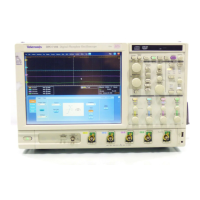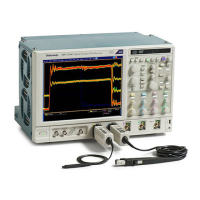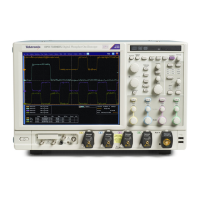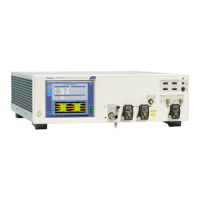Do you have a question about the Tektronix DPO73304DX and is the answer not in the manual?
General safety precautions to avoid injury and product damage during operation.
Safety measures to prevent fire and injury, including proper power cord and grounding.
Details the electromagnetic compatibility standards and declarations for the instrument.
Lists safety standards met by the product, including EU, US, and Canadian certifications.
Specifies environmental and operational conditions necessary for instrument setup and use.
Provides techniques to prevent electrostatic discharge damage to the instrument's sensitive inputs.
Procedure to run built-in diagnostics to verify instrument functionality and detect failures.
Steps to perform signal path compensation for accurate measurements, ensuring optimal performance.
Guide on connecting probes and selecting analog channels for signal acquisition.
Instructions for probe compensation and input channel deskew to maximize measurement accuracy.
Utilizing FastAcq for transients and DSP for extended bandwidth and improved measurements.
Guide on connecting logic probes and setting up digital channels for signal acquisition.
Fundamental concepts of trigger events, modes, and holdoff for accurate signal capture.
Guide to selecting and configuring various trigger types available on the instrument.
Setting up sequential triggering using A and B events for complex signal analysis.
Setting up triggers on parallel and serial buses for detailed protocol analysis.
Magnifying multiple areas of a waveform simultaneously for detailed analysis.
Procedures for creating and adjusting multiple zoom areas on a single waveform.
Utilizing Wave Inspector controls for efficient navigation and analysis of long record length waveforms.
Methods for manually and automatically marking and searching for specific events in waveforms.
Steps to perform automatic measurements on waveform data using various categories.
Using cursors for manual measurements of amplitude and time on acquired data.
Creating and using math waveforms by combining and transforming existing data.
Performing spectral analysis on waveforms to analyze frequency domain characteristics.
Detecting and analyzing errors in serial data streams using the instrument's capabilities.
Comparing signals against predefined masks to verify compliance with standards.
Comparing active signals against template waveforms for pass/fail testing.
Step-by-step guide to creating custom control windows for frequently used instrument functions.
Using FastAcq and advanced triggering to capture infrequent signal anomalies.
Setting up triggers for various bus protocols (I2C, SPI, USB, CAN, etc.) for detailed analysis.
Configuring triggers for video fields (NTSC, SECAM, PAL) and specific video lines.
General safety precautions to avoid injury and product damage during operation.
Safety measures to prevent fire and injury, including proper power cord and grounding.
Details the electromagnetic compatibility standards and declarations for the instrument.
Lists safety standards met by the product, including EU, US, and Canadian certifications.
Specifies environmental and operational conditions necessary for instrument setup and use.
Provides techniques to prevent electrostatic discharge damage to the instrument's sensitive inputs.
Procedure to run built-in diagnostics to verify instrument functionality and detect failures.
Steps to perform signal path compensation for accurate measurements, ensuring optimal performance.
Guide on connecting probes and selecting analog channels for signal acquisition.
Instructions for probe compensation and input channel deskew to maximize measurement accuracy.
Utilizing FastAcq for transients and DSP for extended bandwidth and improved measurements.
Guide on connecting logic probes and setting up digital channels for signal acquisition.
Fundamental concepts of trigger events, modes, and holdoff for accurate signal capture.
Guide to selecting and configuring various trigger types available on the instrument.
Setting up sequential triggering using A and B events for complex signal analysis.
Setting up triggers on parallel and serial buses for detailed protocol analysis.
Magnifying multiple areas of a waveform simultaneously for detailed analysis.
Procedures for creating and adjusting multiple zoom areas on a single waveform.
Utilizing Wave Inspector controls for efficient navigation and analysis of long record length waveforms.
Methods for manually and automatically marking and searching for specific events in waveforms.
Steps to perform automatic measurements on waveform data using various categories.
Using cursors for manual measurements of amplitude and time on acquired data.
Creating and using math waveforms by combining and transforming existing data.
Performing spectral analysis on waveforms to analyze frequency domain characteristics.
Detecting and analyzing errors in serial data streams using the instrument's capabilities.
Comparing signals against predefined masks to verify compliance with standards.
Comparing active signals against template waveforms for pass/fail testing.
Step-by-step guide to creating custom control windows for frequently used instrument functions.
Using FastAcq and advanced triggering to capture infrequent signal anomalies.
Setting up triggers for various bus protocols (I2C, SPI, USB, CAN, etc.) for detailed analysis.
Configuring triggers for video fields (NTSC, SECAM, PAL) and specific video lines.
| Brand | Tektronix |
|---|---|
| Model | DPO73304DX |
| Category | Test Equipment |
| Language | English |











